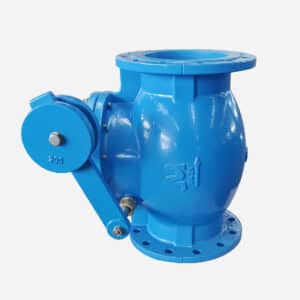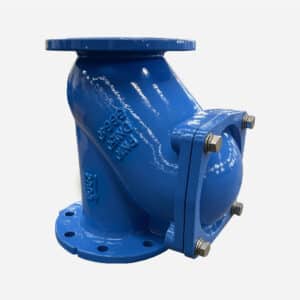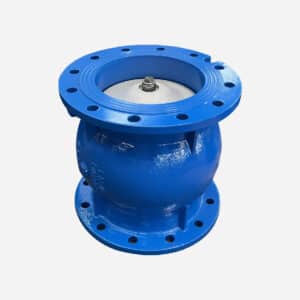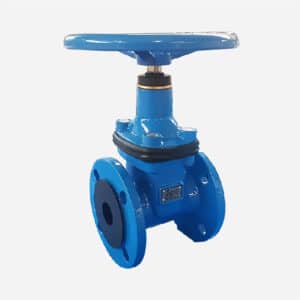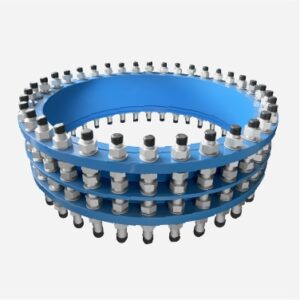Wafer check valve is a compact one-way valve specifically designed to prevent fluid backflow. Its unique design allows it to be installed directly between the two flanges of a pipeline, shaped like a wafer, hence the term wafer check valve. Wafer check valves take up less space and have lower pressure drop.
Judberd is wafer check valves manufacturer in china, please find our wafer check valve as below
FEATURE
● Size from DN50 to dn600
● Material Ductile iron body
● Disc , shaft and spring Stainless steel
● Coating FBE
● With double compression spring
● Static pressure 0 leakage

PARTS

① VALVE BODY
The valve body is the main structural part of the wafer check valve, typically made of metal such as stainless steel, carbon steel, or cast iron. The valve body is disk-shaped, designed to be compact, thin in thickness, and suitable for installation between the flanges of a pipeline.
② DISC OR PLATE
The disc or plate is a critical component of the check valve. When fluid flows in the forward direction, the disc is pushed open, allowing fluid to pass through. When fluid flows in the reverse direction, the disc closes under the force of gravity or a spring, preventing fluid from flowing back. The disc is typically made of a corrosion-resistant metal or alloy.
③ SPRING (DEPENDING ON THE MODEL)
Some wafer check valves have an internal spring to ensure that the disc closes quickly even under low fluid pressure, further preventing backflow. The spring is usually located between the disc and the valve body.
④ SEAT
The seat is the part that the disc contacts. Typically made of metal or rubber material, the seat ensures effective sealing when the disc is closed, preventing fluid leakage.
⑤ SEAL OR GASKET
The seal or gasket is installed between the valve body and the flanges of the pipeline to ensure a seal at the connection point, preventing fluid leakage. The seal or gasket material is usually rubber, PTFE, or other corrosion-resistant materials.
⑥ PIN OR HINGE PIN (DEPENDING ON THE MODEL)
Some wafer check valves use a hinge mechanism, and the disc is connected to the valve body through a pin, allowing the disc to rotate freely on the pin.
WORKING PRINCIPLE
NORMAL FLOW STATE
● FLUID ENTRY
When fluid enters the valve from one side of the pipeline, the pressure of the fluid acts on the disc.
● DISC OPENS
Under sufficient forward fluid pressure, the disc is pushed open, rotating around the pin (if present) or, in a pinless design, translating the entire disc.
● FLUID PASSAGE
The disc is separated from the seat, allowing the fluid to pass freely through the valve and into the other side of the pipeline.
REVERSE FLOW STATE
● FLUID STOPS OR REVERSES
When fluid flow weakens or stops, the disc begins to return under the force of a spring (if present) or gravity.
● DISC CLOSES
If fluid attempts to flow in reverse, the reverse fluid pressure quickly closes the disc, returning it to the seat to form a seal.
● PREVENTING BACKFLOW
The disc contacts the seat, preventing any reverse flow, protecting the security and stability of the system.
DETAILED PROCEDURE
● INITIAL STATE
The valve is in the closed position, with the disc resting on the seat to prevent fluid passage.
● OPENING THE VALVE FOR FORWARD FLOW
Fluid enters the valve from the inlet and outlet.Fluid pressure acts on the disc, causing it to move upward (or sideways), away from the seat.Once the disc is fully open, fluid can pass freely through the valve into the outlet pipe.
● FLOW SLOWS, DISC RETURNS
When forward flow weakens or stops, the disc begins to return under the force of gravity or a spring.The spring (if present) assists the disc in quickly returning to the closed position, especially under low-pressure conditions.
● CLOSING THE VALVE FOR REVERSE FLOW
If fluid attempts to flow in reverse, the reverse fluid pressure pushes the disc back to the seat.The disc contacts the seat to form a seal, preventing fluid from flowing back.

APPLICATION
Wafer check valve is widely used in many industrial and civil applications because of its compact design, easy installation, and low pressure drop.
Here are some typical applications and reasons for choosing a wafer check valve over other types of check valves:
WATER TREATMENT SYSTEMS
Prevents water from flowing back into the pump after it is shut off, protecting the pump and system.The small size and weight of the wafer check valve mean it doesn’t take up much space when installed at the pump discharge. It also provides low pressure drop, saving energy.
HVAC SYSTEMS
Controls the one-way flow of air or cooling liquids in HVAC systems, preventing fluids from flowing back into the system.HVAC systems are typically installed in small mechanical rooms or risers. The compact design of the wafer check valve is ideal for these tight spaces. Additionally, the low pressure drop helps the system operate more efficiently, reducing energy consumption.
INDUSTRIAL PIPING SYSTEMS
Prevents fluid backflow in piping systems in industries such as oil, chemicals, and food processing.Wafer check valves are resistant to corrosion and can handle a variety of chemicals. They are easy to install and maintain, reducing downtime and maintenance costs.
BOILER SYSTEMS
Installed on the outlet of boilers or steam lines to prevent steam or hot water from flowing back.Wafer check valves are designed to handle high temperatures and pressures and provide reliable backflow protection in harsh working conditions.
FIRE PROTECTION SYSTEMS
Used in fire protection water piping systems to prevent water from flowing back into the water source or pump station.Fire protection systems require equipment that is highly reliable and quick to respond. The spring-loaded mechanism of the wafer check valve can quickly close the valve, providing effective backflow protection.
WHY CHOOSE A WAFER CHECK VALVE?
COMPACT DESIGN
_
The wafer check valve is compact and takes up little space. This makes it ideal for installation in tight spaces such as risers, mechanical rooms, and inside equipment.
LOW PRESSURE DROP
_
The streamlined design of the wafer check valve minimizes fluid resistance in the open position. This reduces pressure loss in the system and improves overall system efficiency.
EASY INSTALLATION
_
Because of its lightweight construction, the wafer check valve can be placed directly between the flanges of the piping without additional support or complex installation steps. It is easy to install and maintain.
HIGH RELIABILITY
_
The wafer check valve has excellent sealing properties and rapid response capabilities. Particularly, the spring-loaded models can close quickly under low fluid pressure to prevent backflow.
VERSATILE
_
The wafer check valve can be used in a variety of conditions, including high temperature, high pressure, and corrosive environments. With a variety of material choices, it can meet the needs of various industrial applications.
COST-EFFECTIVE
_
Compared to other types of check valves, such as lift check valves or swing check valves, the wafer check valve has lower manufacturing and maintenance costs while providing efficient backflow protection.
Through the above analysis, it can be seen that the wafer check valve has unique advantages in many applications,
especially in piping systems with limited space, low pressure drop requirements, and high reliability. The wafer check valve is an ideal choice.

INSTALLATION
INSTALLATION PREPARATION
CHECK THE VALVE
_
Before installation, check the valve to make sure it is in good condition and free of foreign objects inside.
CHECK THE PIPE FLANGES
_
Ensure that the pipe flanges are clean, flat, and that the flange spacing meets the thickness requirements of the valve.
CONFIRM THE FLOW DIRECTION
_
According to the flow direction arrow on the valve body, ensure that the valve is installed in the same direction as the fluid flow in the piping system.
INSTALLATION STEPS
01
PREPARE THE INSTALLATION POSITION
_
Make sure the pipe flanges at the installation location meet the installation requirements of the wafer check valve, and the spacing between the flanges matches the thickness of the valve.
02
PLACE THE SEALING GASKET
_
Place the appropriate sealing gaskets between the pipe flanges to ensure a good seal when the valve is installed. Typically, a sealing gasket is placed on each side of the flange.
03
POSITION THE VALVE
_
Carefully place the wafer check valve between the two flanges and ensure the flow direction arrow of the valve matches the direction of fluid flow in the piping.
04
ADJUST THE VALVE POSITION
_
Align with the flange holes and ensure the valve is centered between the flanges.
05
INSERT AND SECURE THE BOLTS
_
Nsert the bolts into the bolt holes of the flanges one by one and tighten them gradually. It is recommended to tighten the bolts in a diagonal manner (i.e., “criss-cross”) gradually to ensure even force and prevent valve deformation and leakage.After the initial tightening, check the position of the valve to ensure it is correct, then tighten the bolts in a diagonal manner again until the specified torque is reached.
06
CHECK THE INSTALLATION
_
After installation is complete, check the sealing between the valve and the flanges to ensure there is no loosening or leakage.Check that the valve can open and close freely to ensure it is functioning properly.
NOTE
CORRECT DIRECTION
Always ensure that the flow direction arrow of the valve is consistent with the direction of fluid flow.
BALANCED INSTALLATION
Tighten the bolts in a diagonal manner to ensure even force on the valve and avoid deformation.
REGULAR INSPECTION
After installation, regularly check the operation of the valve to ensure it remains in good condition.
The process of installing a wafer check valve is not complicated,
but attention to detail is necessary to ensure that the valve is installed correctly and operates normally.
By following the above steps, you can effectively install wafer check valves to ensure the safety and stable operation of the system.
COMMON PROBLEMS AND CAUSES
LEAKAGE
_
● Reason
1,Seal ring is damaged or worn.
2,The valve body or seat is corroded.
3,Improper installation results in loose flange connection.
● Solution
1,Regularly check and replace the seal ring.
2,Choose valves made of corrosion-resistant materials suitable for the working conditions.
3,Ensure that the flange bolts are evenly tightened during installation to ensure a tight connection.
VALVE STICKING
_
● Reason
1,Impurities or foreign objects in the pipeline.
2,Too small a gap between the valve and seat leads to wear or sticking.
3,The spring (if any) fails or breaks.
● Solution
Check the condition of the ball and replace it if necessary.
Clean the inside of the valve to remove all foreign matter.
WATER HAMMER
_
● Reason
1,The fluid suddenly stops or changes direction, causing pressure fluctuations.
2,The valve closes too quickly, causing fluid recoil.
● Solution
1,Install a buffer or pressure reducing valve in the system design to reduce pressure fluctuations.
2,Use valves with a slow closing function or a design that slows down the valve closing speed.
NOISE
_
● Reason
1,Fluid flow instability or vortex formation inside the valve.
2,Improper selection of valve size, resulting in excessive flow velocity.
● Solution
1,Ensure the valve is installed in a stable fluid environment to avoid vortices.
2,Select the appropriate valve size based on system flow to avoid excessive flow rates. during installation to ensure a tight connection.
VALVE WEAR
_
● Reason
1,The valve is frequently opened and closed, leading to increased wear.
2,The fluid contains particles that damage the valve surface.
● Solution
1,Use valve discs made of wear-resistant materials.
2,Install filters in the fluid system to reduce the entry of particles.
HOW TO AVOID THESE PROBLEMS
CORRECT SELECTION
_
Select the appropriate wafer check valve material and size based on the system’s working pressure, temperature, and medium characteristics.
REGULAR MAINTENANCE
_
Establish a regular maintenance plan, regularly check the various components of the valve, and promptly replace worn or damaged components.
CORRECT INSTALLATION
_
Ensure the valve is correctly installed according to the manufacturer’s installation instructions, ensuring a tight flange connection with no leaks.
SYSTEM DESIGN OPTIMIZATION
_
Consider pressure relief and buffering measures during system design to avoid water hammer and pressure fluctuations.Install filters to reduce the impact of impurities on the valve.
OPERATIONAL SPECIFICATION
_
Avoid frequent starting and stopping and sudden changes in flow direction during system operation, maintaining stable fluid flow.
By following the above methods, you can effectively reduce the occurrence of common problems with wafer check valves during use to ensure the safety and stable operation of the system.


